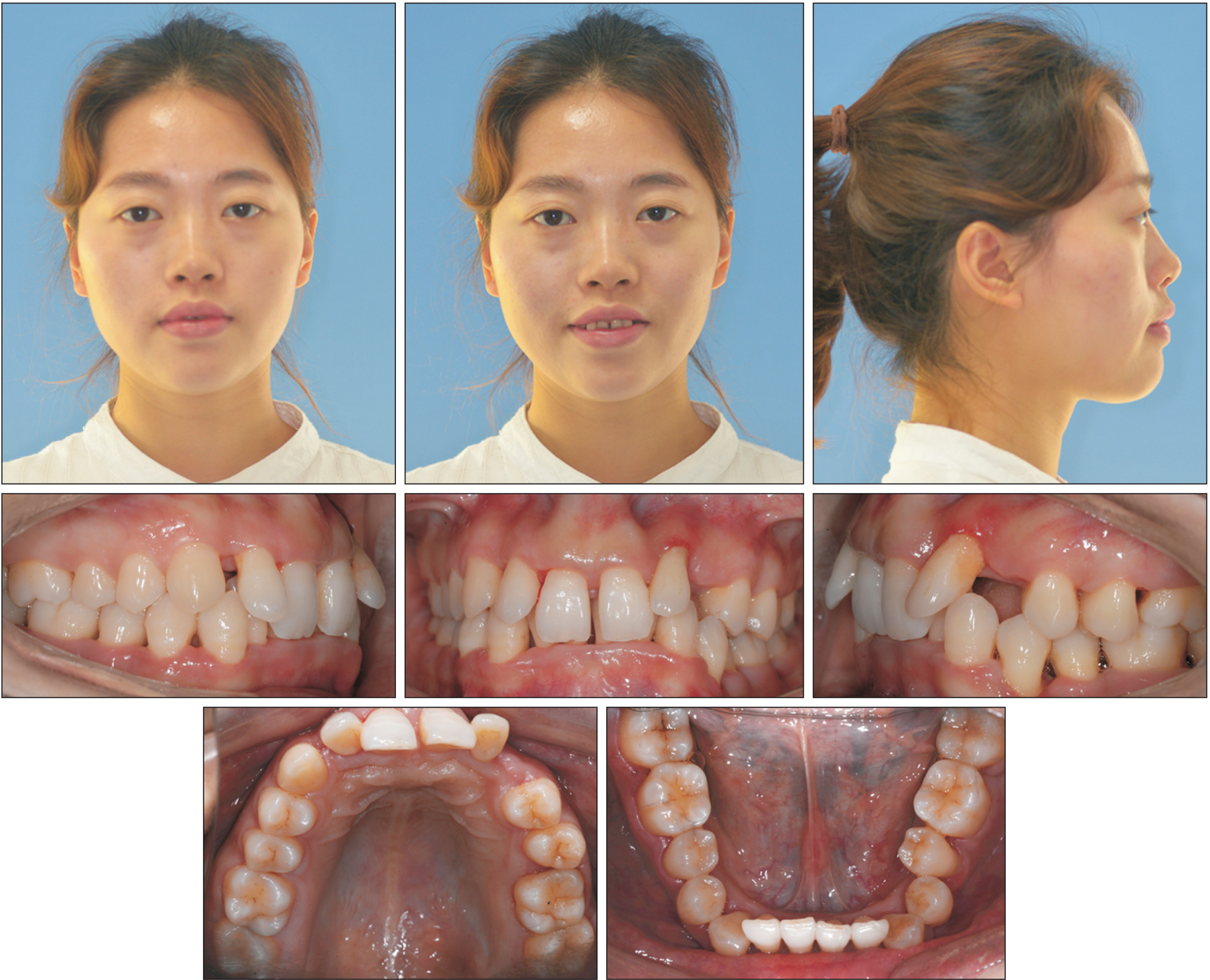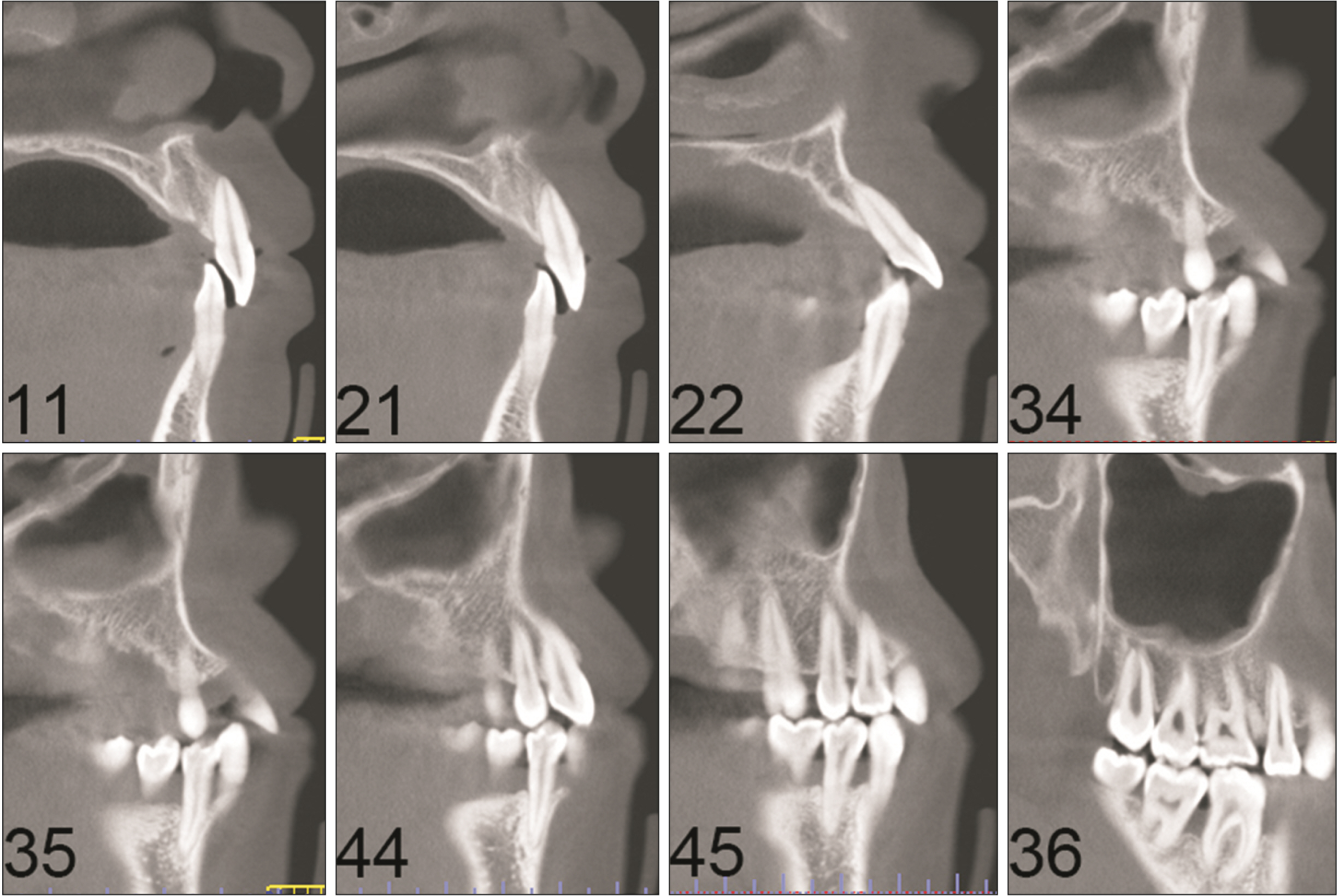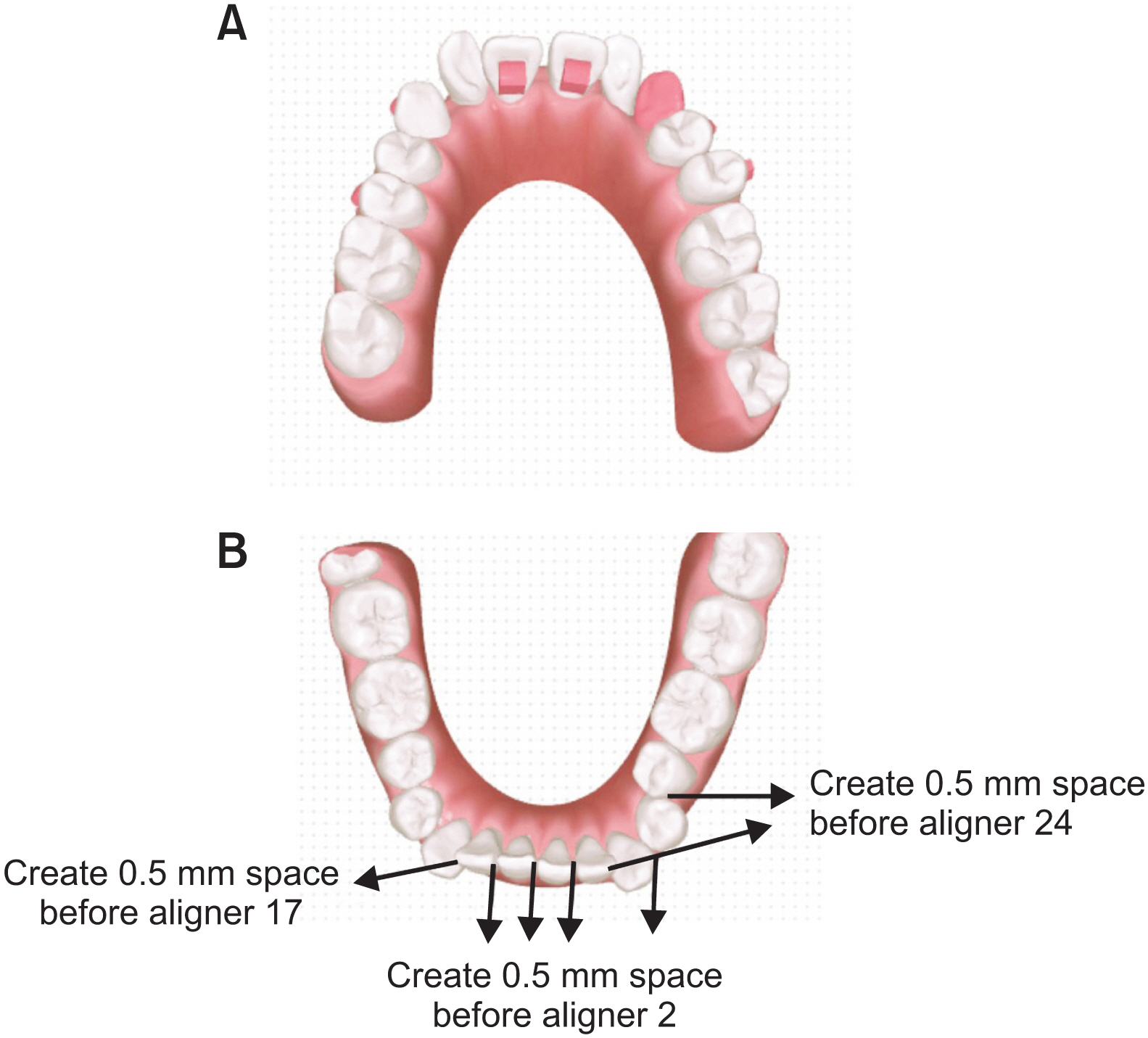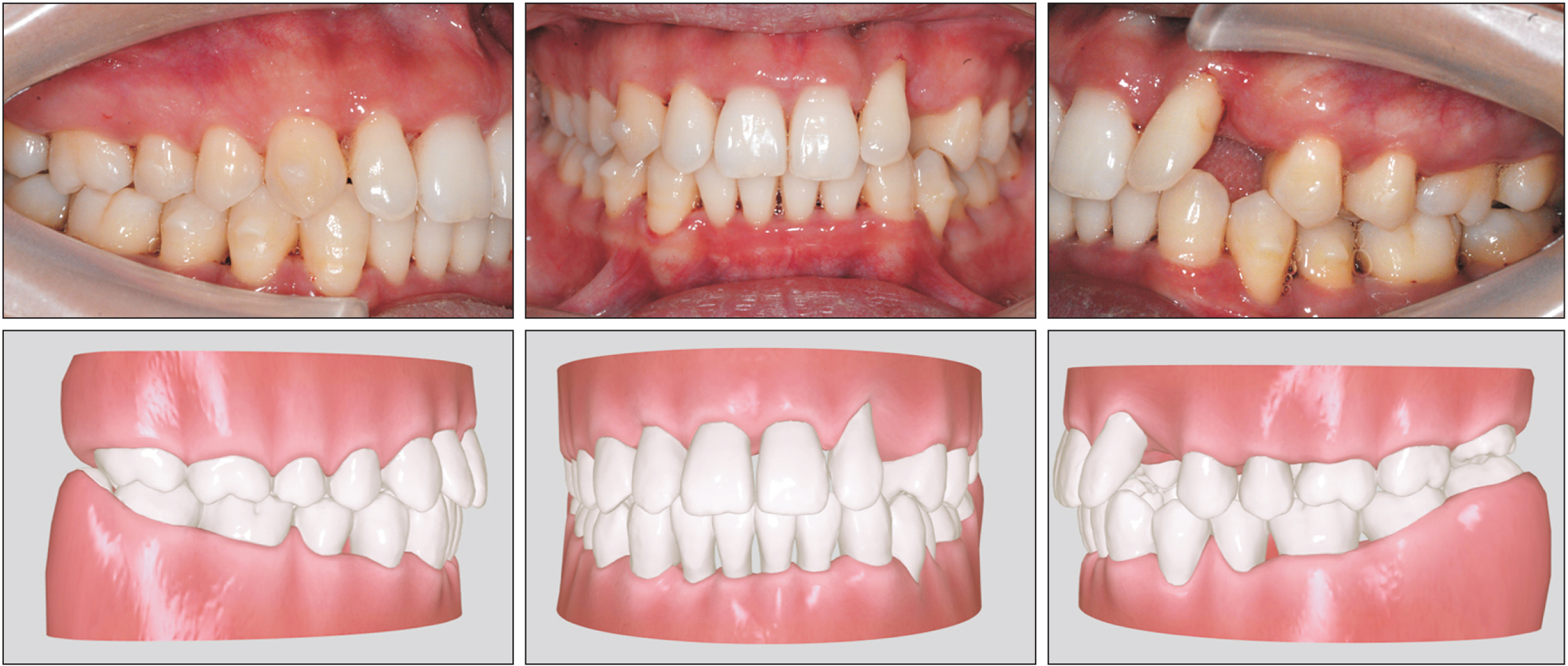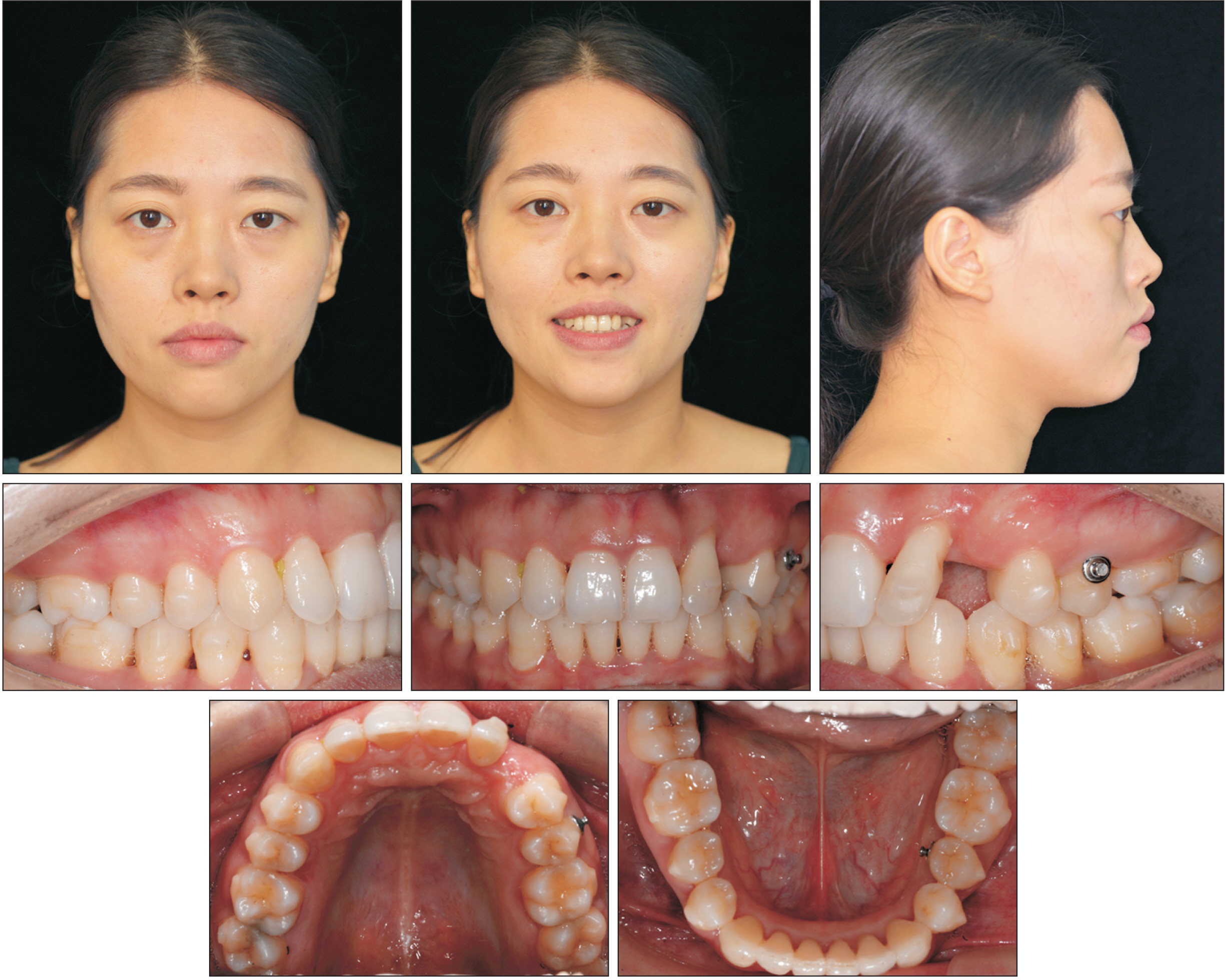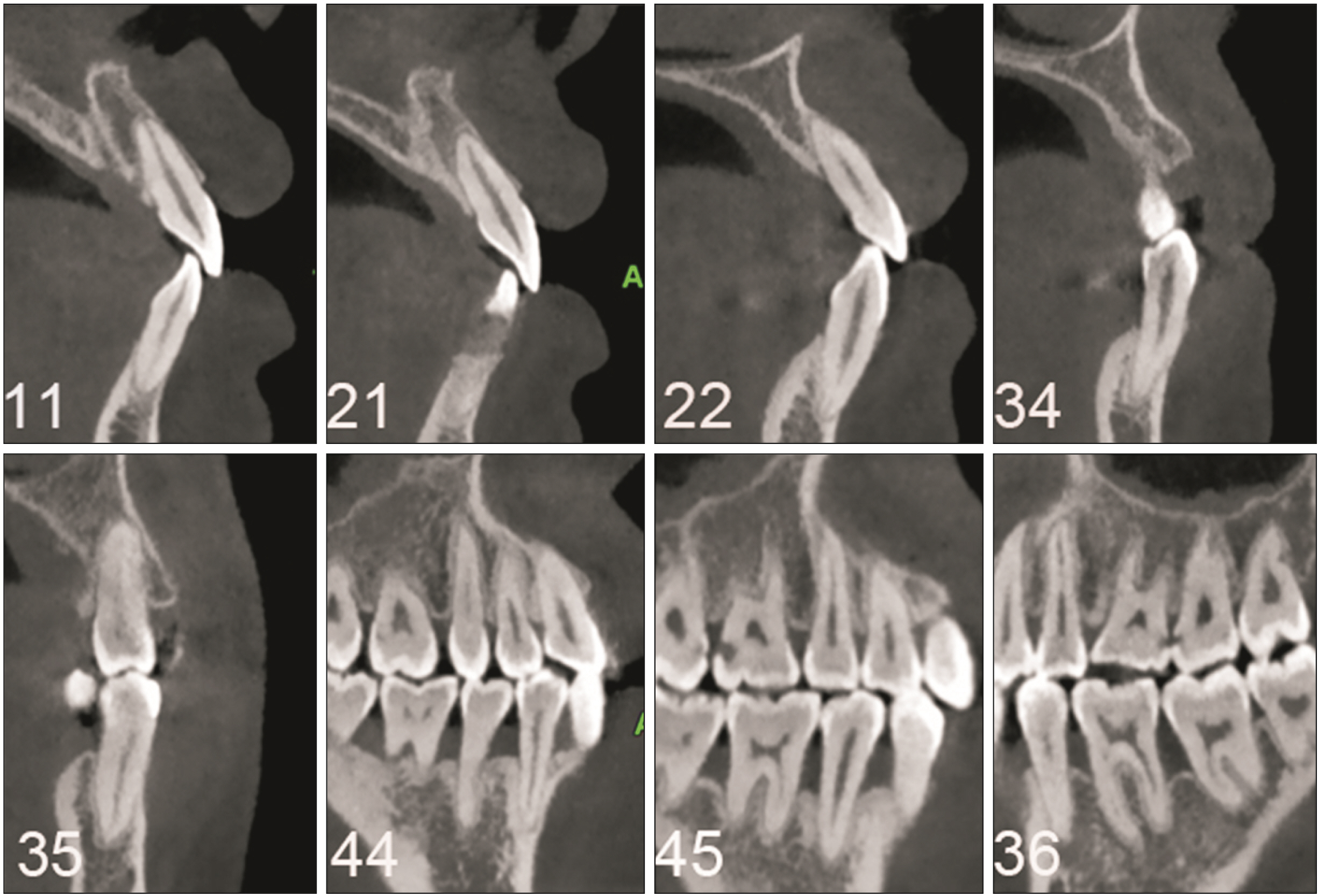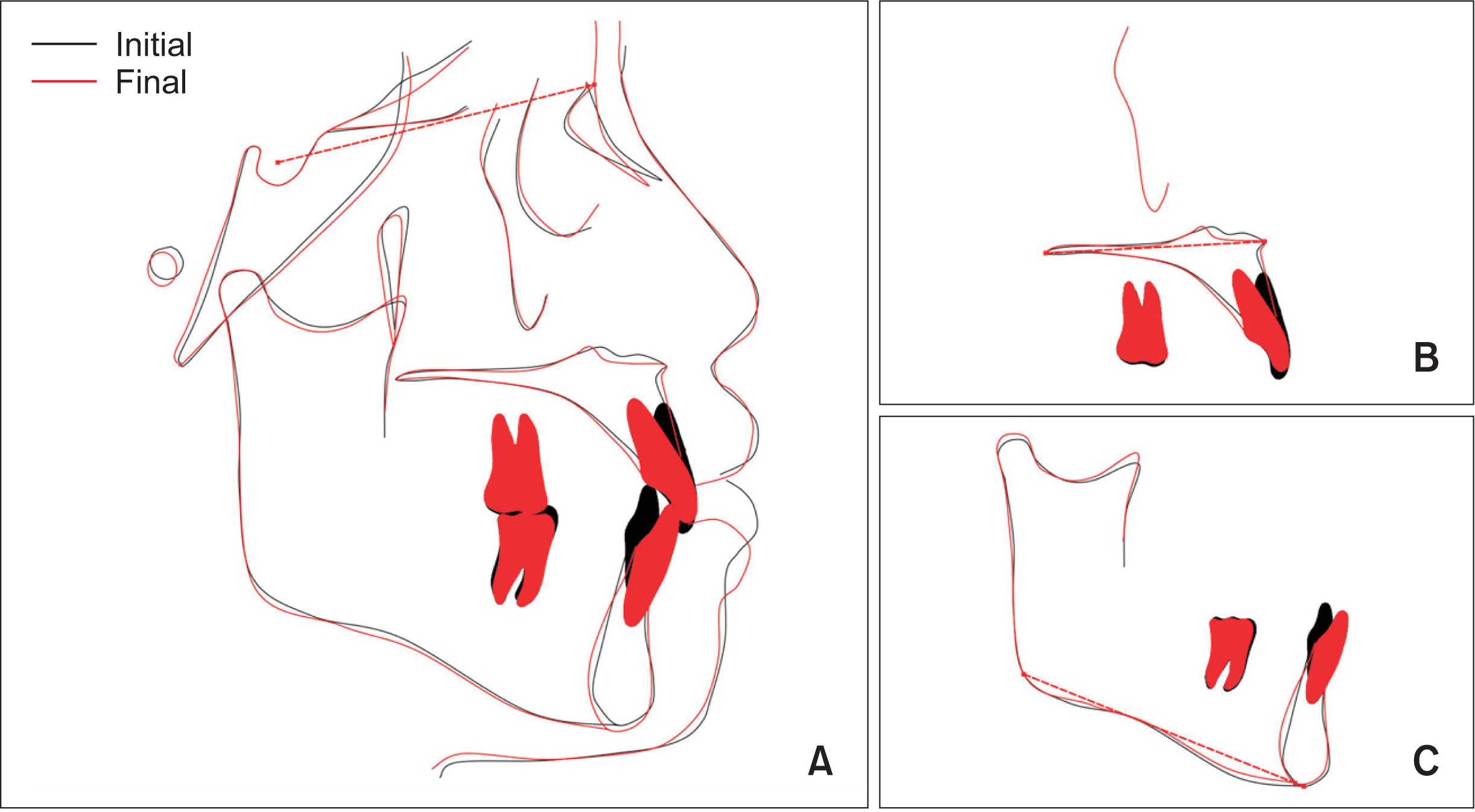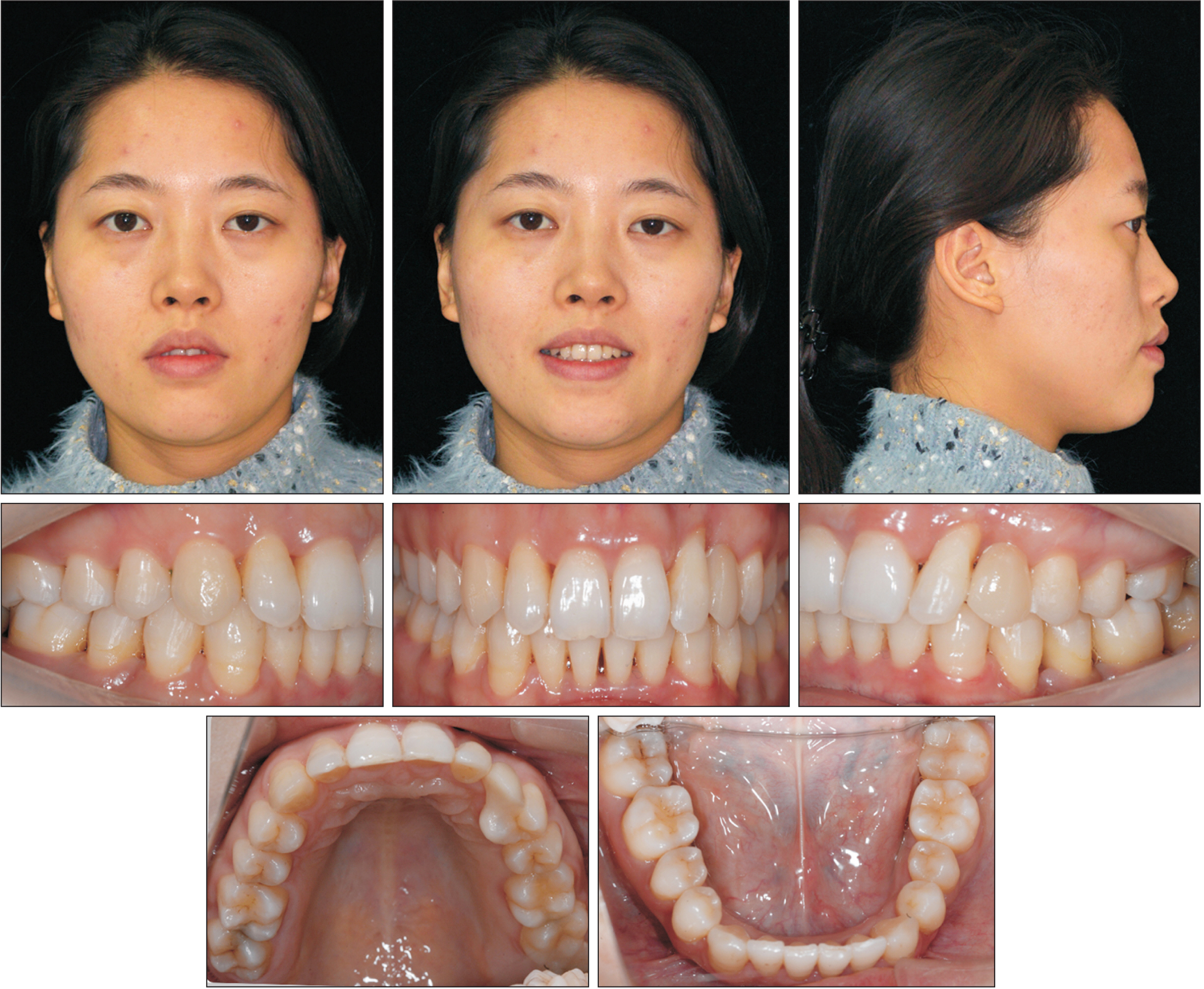Korean J Orthod.
2022 Nov;52(6):439-450. 10.4041/kjod21.263.
Orthodontic treatment with clear aligners for a patient with chronic periodontitis
- Affiliations
-
- 1Department of Stomatology, Renmin Hospital of Wuhan University, Wuhan, Hubei, China
- KMID: 2536337
- DOI: http://doi.org/10.4041/kjod21.263
Abstract
- This case report describes the treatment of an adult female patient with a history of periodontal disease, Class I malocclusion with extrusion, dental spaces, and pathologic tooth migration. The patient was treated with clear aligners, which effectively controlled the strength and direction of orthodontic forces after 3 months of systematic periodontal treatment. The Peer Assessment Rating (PAR) index was calculated from study models before and after treatment. The pretreatment PAR score was 24, and the posttreatment PAR score was 4. The PAR score for this patient changed by 83%. Satisfactory appearance and good function were achieved for this patient.
Keyword
Figure
Reference
-
1. Nazir MA. 2017; Prevalence of periodontal disease, its association with systemic diseases and prevention. Int J Health Sci (Qassim). 11:72–80. PMID: 28539867. PMCID: PMC5426403.2. Hirschfeld J, Reichardt E, Sharma P, Hilber A, Meyer-Marcotty P, Stellzig-Eisenhauer A, et al. 2019; Interest in orthodontic tooth alignment in adult patients affected by periodontitis: a questionnaire-based cross-sectional pilot study. J Periodontol. 90:957–65. DOI: 10.1002/JPER.18-0578. PMID: 30950037. PMID: https://www.scopus.com/inward/record.uri?partnerID=HzOxMe3b&scp=85072057575&origin=inward.3. Bollen AM, Cunha-Cruz J, Bakko DW, Huang GJ, Hujoel PP. 2008; The effects of orthodontic therapy on periodontal health: a systematic review of controlled evidence. J Am Dent Assoc. 139:413–22. DOI: 10.14219/jada.archive.2008.0184. PMID: 18385025. PMID: https://www.scopus.com/inward/record.uri?partnerID=HzOxMe3b&scp=42349091008&origin=inward.4. Roccuzzo M, Marchese S, Dalmasso P, Roccuzzo A. 2018; Periodontal regeneration and orthodontic treatment of severely periodontally compromised teeth: 10-year results of a prospective study. Int J Periodontics Restorative Dent. 38:801–9. DOI: 10.11607/prd.3756. PMID: 30304070. PMID: https://www.scopus.com/inward/record.uri?partnerID=HzOxMe3b&scp=85055100844&origin=inward.5. Zhang J, Zhang AM, Zhang ZM, Jia JL, Sui XX, Yu LR, et al. 2017; Efficacy of combined orthodontic-periodontic treatment for patients with periodontitis and its effect on inflammatory cytokines: a comparative study. Am J Orthod Dentofacial Orthop. 152:494–500. DOI: 10.1016/j.ajodo.2017.01.028. PMID: 28962734. PMID: https://www.scopus.com/inward/record.uri?partnerID=HzOxMe3b&scp=85031719520&origin=inward.6. Khorsand A, Paknejad M, Yaghobee S, Ghahroudi AA, Bashizadefakhar H, Khatami M, et al. 2013; Periodontal parameters following orthodontic treatment in patients with aggressive periodontitis: a before-after clinical study. Dent Res J (Isfahan). 10:744–51. PMID: 24379862. PMCID: PMC3872625.7. Maeda S, Maeda Y, Ono Y, Nakamura K, Matsui T. 2007; Interdisciplinary approach and orthodontic options for treatment of advanced periodontal disease and malocclusion: a case report. Quintessence Int. 38:653–62. PMID: 17823683. PMID: https://www.scopus.com/inward/record.uri?partnerID=HzOxMe3b&scp=34547801380&origin=inward.8. Cao T, Xu L, Shi J, Zhou Y. 2015; Combined orthodontic-periodontal treatment in periodontal patients with anteriorly displaced incisors. Am J Orthod Dentofacial Orthop. 148:805–13. DOI: 10.1016/j.ajodo.2015.05.026. PMID: 26522041. PMID: https://www.scopus.com/inward/record.uri?partnerID=HzOxMe3b&scp=84946034843&origin=inward.9. Paolone MG, Kaitsas R. 2018; Orthodontic-periodontal interactions: orthodontic extrusion in interdisciplinary regenerative treatments. Int Orthod. 16:217–45. DOI: 10.1016/j.ortho.2018.03.019. PMID: 29661677. PMID: https://www.scopus.com/inward/record.uri?partnerID=HzOxMe3b&scp=85045564003&origin=inward.10. Feng YM, Fang B, Xia Yh, Shu R, Hans MG. 2009; Mia-assisted orthodontic treatment for dental malocclusion secondary to periodontal disease. World J Orthod. 10:49–56. PMID: 19388433. PMID: https://www.scopus.com/inward/record.uri?partnerID=HzOxMe3b&scp=68049100226&origin=inward.11. Geron S. 2004; Managing the orthodontic treatment of patients with advanced periodontal disease: the lingual appliance. World J Orthod. 5:324–31. PMID: 15633379. PMID: https://www.scopus.com/inward/record.uri?partnerID=HzOxMe3b&scp=14944372114&origin=inward.12. Aldeeri A, Alhammad L, Alduham A, Ghassan W, Shafshak S, Fatani E. 2018; Association of orthodontic clear aligners with root resorption using three-dimension measurements: a systematic review. J Contemp Dent Pract. 19:1558–64. DOI: 10.5005/jp-journals-10024-2465. PMID: 30713189. PMID: https://www.scopus.com/inward/record.uri?partnerID=HzOxMe3b&scp=85059915268&origin=inward.13. Aman C, Azevedo B, Bednar E, Chandiramami S, German D, Nicholson E, et al. 2018; Apical root resorption during orthodontic treatment with clear aligners: a retrospective study using cone-beam computed tomography. Am J Orthod Dentofacial Orthop. 153:842–51. DOI: 10.1016/j.ajodo.2017.10.026. PMID: 29853242. PMID: https://www.scopus.com/inward/record.uri?partnerID=HzOxMe3b&scp=85047523249&origin=inward.14. Jiang Q, Li J, Mei L, Du J, Levrini L, Abbate GM, et al. 2018; Periodontal health during orthodontic treatment with clear aligners and fixed appliances: a meta-analysis. J Am Dent Assoc. 149:712–20.e12. DOI: 10.1016/j.adaj.2018.04.010. PMID: 29921415. PMID: https://www.scopus.com/inward/record.uri?partnerID=HzOxMe3b&scp=85048510284&origin=inward.15. Xie Y, Zhao Q, Tan Z, Yang S. 2014; Orthodontic treatment in a periodontal patient with pathologic migration of anterior teeth. Am J Orthod Dentofacial Orthop. 145:685–93. DOI: 10.1016/j.ajodo.2013.08.018. PMID: 24785933. PMID: https://www.scopus.com/inward/record.uri?partnerID=HzOxMe3b&scp=84899761599&origin=inward.16. Wheeler TT. 2017; Orthodontic clear aligner treatment. Semin Orthod. 23:83–9. DOI: 10.1053/j.sodo.2016.10.009. PMID: https://www.scopus.com/inward/record.uri?partnerID=HzOxMe3b&scp=85014105169&origin=inward.17. Han JY. 2015; A comparative study of combined periodontal and orthodontic treatment with fixed appliances and clear aligners in patients with periodontitis. J Periodontal Implant Sci. 45:193–204. DOI: 10.5051/jpis.2015.45.6.193. PMID: 26734489. PMCID: PMC4698945. PMID: https://www.scopus.com/inward/record.uri?partnerID=HzOxMe3b&scp=84953853261&origin=inward.18. Ishihara Y, Tomikawa K, Deguchi T, Honjo T, Suzuki K, Kono T, et al. 2015; Interdisciplinary orthodontic treatment for a patient with generalized aggressive periodontitis: assessment of IgG antibodies to identify type of periodontitis and correct timing of treatment. Am J Orthod Dentofacial Orthop. 147:766–80. DOI: 10.1016/j.ajodo.2014.09.022. PMID: 26038081. PMID: https://www.scopus.com/inward/record.uri?partnerID=HzOxMe3b&scp=84930427726&origin=inward.19. Tavares CA, Allgayer S, Calvete Eda S, Polido WD. 2013; Orthodontic treatment for a patient with advanced periodontal disease: 11-year follow-up. Am J Orthod Dentofacial Orthop. 144:455–65. DOI: 10.1016/j.ajodo.2012.09.025. PMID: 23992818. PMID: https://www.scopus.com/inward/record.uri?partnerID=HzOxMe3b&scp=84886399235&origin=inward.20. Türkkahraman H, Sayin MO, Bozkurt FY, Yetkin Z, Kaya S, Onal S. 2005; Archwire ligation techniques, microbial colonization, and periodontal status in orthodontically treated patients. Angle Orthod. 75:231–6. DOI: 10.1016/s0084-3717(08)70201-0. PMID: 15825788.21. Boyd RL. 2007; Complex orthodontic treatment using a new protocol for the Invisalign appliance. J Clin Orthod. 41:525–47. quiz 523PMID: 29130926. PMID: https://www.scopus.com/inward/record.uri?partnerID=HzOxMe3b&scp=85068449926&origin=inward.22. Eissa O, Carlyle T, El-Bialy T. 2018; Evaluation of root length following treatment with clear aligners and two different fixed orthodontic appliances. A pilot study. J Orthod Sci. 7:11. DOI: 10.4103/jos.JOS_120_17. PMID: 29963506. PMCID: PMC6004740. PMID: https://www.scopus.com/inward/record.uri?partnerID=HzOxMe3b&scp=85053304462&origin=inward.23. Lee JW, Lee SJ, Lee CK, Kim BO. 2011; Orthodontic treatment for maxillary anterior pathologic tooth migration by periodontitis using clear aligner. J Periodontal Implant Sci. 41:44–50. DOI: 10.5051/jpis.2011.41.1.44. PMID: 21394296. PMCID: PMC3051056. PMID: https://www.scopus.com/inward/record.uri?partnerID=HzOxMe3b&scp=84859148012&origin=inward.
- Full Text Links
- Actions
-
Cited
- CITED
-
- Close
- Share
- Similar articles
-
- A comparative study of combined periodontal and orthodontic treatment with fixed appliances and clear aligners in patients with periodontitis
- Changes in force associated with the amount of aligner activation and lingual bodily movement of the maxillary central incisor
- The combined use of computer-guided, minimally invasive, flapless corticotomy and clear aligners as a novel approach to moderate crowding: A case report
- Force changes associated with differential activation of en-masse retraction and/or intrusion with clear aligners
- Orthodontic treatment using indirect bonding technique in periodontitis

